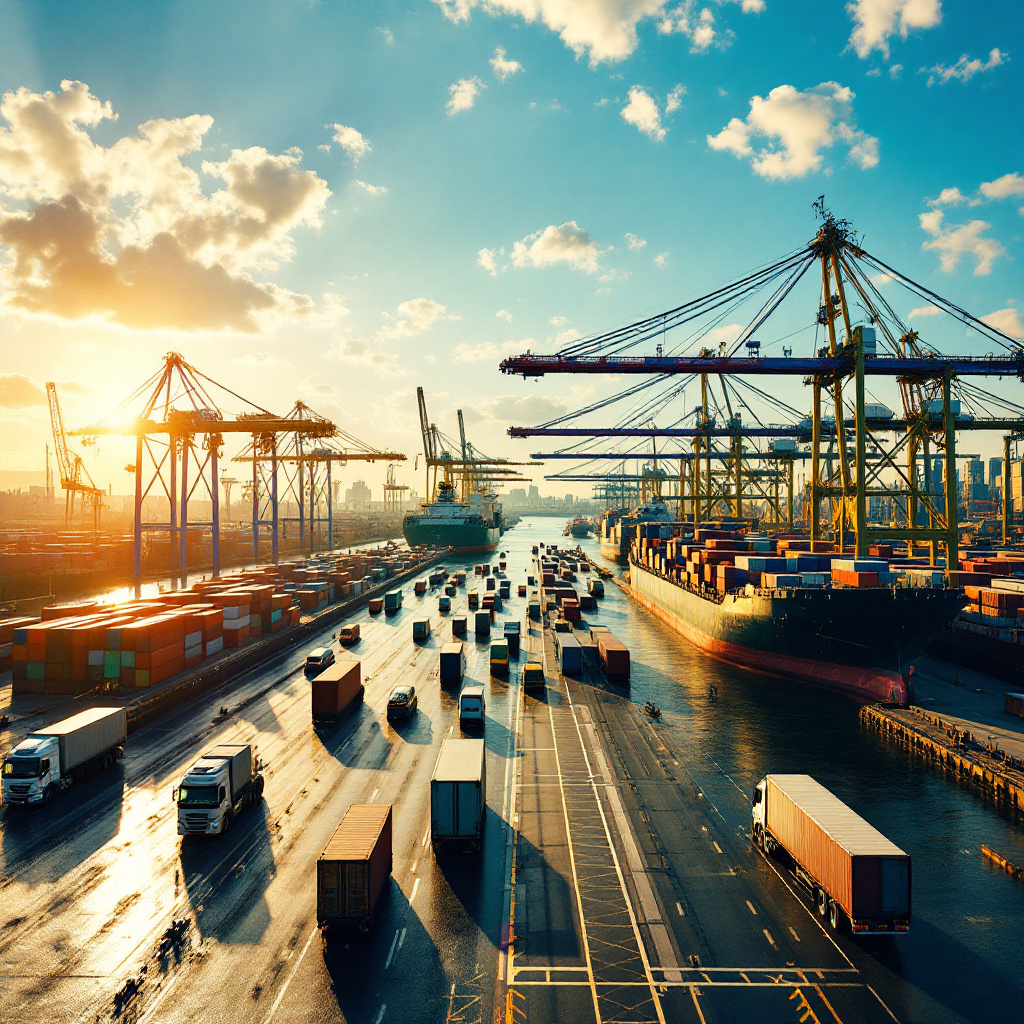Η Αυστραλία, γνωστή για τα απέραντα τοπία και τις απομακρυσμένες κοινότητές της, παρουσιάζει μοναδικές προκλήσεις για τα logistics και τη διαχείριση της εφοδιαστικής αλυσίδας. Οι μεγάλες πόλεις της χώρας, όπως το Σίδνεϊ και η Μελβούρνη, είναι καλά συνδεδεμένες, αλλά η μεταφορά αγαθών σε αγροτικές και απομακρυσμένες περιοχές απαιτεί προηγμένο σχεδιασμό, καινοτόμες λύσεις και σημαντικές επενδύσεις. Παρά τις προκλήσεις αυτές, η Αυστραλία έχει αναπτύξει ένα ισχυρό δίκτυο εφοδιαστικής, το οποίο συνεχίζει να εξελίσσεται με τις τεχνολογικές εξελίξεις και τις βελτιώσεις των υποδομών. Το παρόν άρθρο διερευνά τα βασικά εμπόδια στην αυστραλιανή εφοδιαστική και τις στρατηγικές που χρησιμοποιούνται για τη διασφάλιση αποτελεσματικών λειτουργιών της εφοδιαστικής αλυσίδας.
Προκλήσεις στην αυστραλιανή εφοδιαστική
1. Τεράστιες αποστάσεις και χαμηλή πυκνότητα πληθυσμού
Το μέγεθος της Αυστραλίας καθιστά την εφοδιαστική πολύπλοκη. Με πάνω από 7,6 εκατομμύρια τετραγωνικά χιλιόμετρα γης αλλά σχετικά μικρό πληθυσμό, η μετακίνηση αγαθών μεταξύ περιοχών είναι δαπανηρή και χρονοβόρα. Πολλές απομακρυσμένες κοινότητες απέχουν εκατοντάδες ή και χιλιάδες χιλιόμετρα από τα μεγάλα κέντρα διανομής, αυξάνοντας την κατανάλωση καυσίμων και το κόστος μεταφοράς.
2. Περιορισμοί υποδομών
Ενώ η Αυστραλία διαθέτει σύγχρονους αυτοκινητόδρομους, σιδηροδρομικά δίκτυα και λιμάνια, οι υποδομές στις απομακρυσμένες περιοχές είναι συχνά υποβαθμισμένες. Πολλοί αγροτικοί δρόμοι δεν είναι ασφαλτοστρωμένοι ή υπόκεινται σε ακραίες καιρικές συνθήκες, καθιστώντας τις μεταφορές αναξιόπιστες. Η σιδηροδρομική συνδεσιμότητα είναι επίσης περιορισμένη, ιδίως στο εσωτερικό της χώρας, καθιστώντας τις οδικές εμπορευματικές μεταφορές τον κύριο τρόπο μεταφοράς.
3. Δυσμενείς κλιματικές συνθήκες
Οι ακραίες θερμοκρασίες, οι κυκλώνες και οι πλημμύρες επηρεάζουν συχνά την εφοδιαστική στην Αυστραλία. Το σκληρό κλίμα επηρεάζει τις οδικές συνθήκες και αυξάνει τον κίνδυνο διακοπής της αλυσίδας εφοδιασμού, ιδίως στα βόρεια και κεντρικά τμήματα της χώρας.
4. Υψηλό κόστος μεταφορών
Το κόστος καυσίμων, οι ελλείψεις εργατικού δυναμικού και τα έξοδα μεταφοράς σε μεγάλες αποστάσεις αυξάνουν το κόστος εφοδιαστικής στην Αυστραλία. Σε σύγκριση με άλλα ανεπτυγμένα έθνη, το κόστος μεταφοράς αγαθών σε όλη τη χώρα είναι σημαντικά υψηλότερο λόγω των μεγάλων αποστάσεων και της έλλειψης εναλλακτικών επιλογών μεταφοράς σε απομακρυσμένες περιοχές.
Logistics στην Αυστραλία: Αυστραλία: Λύσεις και καινοτομίες
1. Επενδύσεις σε υποδομές
Η αυστραλιανή κυβέρνηση και ο ιδιωτικός τομέας επενδύουν σημαντικά στη βελτίωση των υποδομών. Οι βασικές πρωτοβουλίες περιλαμβάνουν:
- Οδικές αναβαθμίσεις: Επέκταση και συντήρηση βασικών αυτοκινητοδρόμων, όπως η Outback Way, για τη βελτίωση της συνδεσιμότητας.
- Ανάπτυξη σιδηροδρομικών εμπορευματικών μεταφορών: Το έργο Inland Rail ενισχύει την αποτελεσματικότητα των σιδηροδρομικών εμπορευματικών μεταφορών, μειώνοντας την εξάρτηση από τα φορτηγά μεγάλων αποστάσεων.
- Επέκταση λιμένα: Τα μεγάλα λιμάνια, συμπεριλαμβανομένων εκείνων του Μπρίσμπεϊν και του Περθ, επεκτείνονται για να εξυπηρετήσουν τον αυξημένο όγκο εμπορίου.
2. Πολυτροπικό Μεταφορά
Για να βελτιστοποιήσουν τη διακίνηση εμπορευμάτων, οι εταιρείες ενσωματώνουν τις οδικές, σιδηροδρομικές, αεροπορικές και θαλάσσιες μεταφορές. Με τη χρήση σιδηροδρόμων για μεταφορές μεγάλων αποστάσεων και φορτηγών για την παράδοση του τελευταίου χιλιομέτρου, οι πάροχοι εφοδιαστικής μπορούν να βελτιώσουν την αποτελεσματικότητα και να μειώσουν το κόστος.
3. Τεχνολογία και ψηφιοποίηση
Η σύγχρονη τεχνολογία παίζει καθοριστικό ρόλο στην ενίσχυση της εφοδιαστικής σε απομακρυσμένες περιοχές:
- Παρακολούθηση GPS και IoT: Η παρακολούθηση αποστολών σε πραγματικό χρόνο επιτρέπει καλύτερο σχεδιασμό διαδρομών και παρακολούθηση φορτίου.
- Αυτοματοποιημένη αποθήκευση: Η ρομποτική και οι αποθήκες με τεχνητή νοημοσύνη βελτιώνουν τη διαχείριση των αποθεμάτων και την εκτέλεση των παραγγελιών.
- Blockchain για τη διαφάνεια της αλυσίδας εφοδιασμού: Η ασφαλής ανταλλαγή δεδομένων διασφαλίζει τη λογοδοσία και την αποτελεσματικότητα των εργασιών εφοδιαστικής.
4. Λύσεις για drone και αεροπορικές εμπορευματικές μεταφορές
Σε εξαιρετικά απομακρυσμένες περιοχές, τα μη επανδρωμένα αεροσκάφη και οι αεροπορικές μεταφορές γίνονται βιώσιμες εναλλακτικές λύσεις. Τα μη επανδρωμένα αεροσκάφη δοκιμάζονται για ιατρικές παραδόσεις και παραδόσεις προμηθειών έκτακτης ανάγκης σε απομονωμένες κοινότητες, ενώ οι περιφερειακές υπηρεσίες αεροπορικών εμπορευματικών μεταφορών επεκτείνονται για την υποστήριξη απομακρυσμένων επιχειρήσεων.
5. Βιώσιμη εφοδιαστική
Η Αυστραλία εστιάζει στη μείωση του αποτυπώματος άνθρακα του τομέα της εφοδιαστικής της. Οι πρωτοβουλίες περιλαμβάνουν:
- Ηλεκτρικά και υδρογονοκίνητα φορτηγά: Οι μεγάλες εταιρείες logistics υιοθετούν πιο πράσινες εναλλακτικές λύσεις για τη μείωση των εκπομπών.
- Βελτιστοποίηση διαδρομής: Τα συστήματα με τεχνητή νοημοσύνη βοηθούν στην εύρεση των πιο αποδοτικών διαδρομών.
- Συσκευασία φιλική προς το περιβάλλον: Οι επιχειρήσεις στρέφονται σε βιώσιμα υλικά για να μειώσουν τα απόβλητα.
Logistics στην Αυστραλία: Αυστραλία: Περιφερειακές πληροφορίες
1. Δυτική Αυστραλία
Η Δυτική Αυστραλία, όπου εδρεύουν μεγάλες εξορυκτικές επιχειρήσεις, βασίζεται σε μεγάλο βαθμό στις μεταφορές φορτηγών μεγάλων αποστάσεων και σε εξειδικευμένες λύσεις εφοδιαστικής για τη μεταφορά ορυκτών και εξοπλισμού.
2. Βόρεια Επικράτεια
Ο αραιός πληθυσμός και οι τεράστιες αποστάσεις καθιστούν την εφοδιαστική εδώ σε μεγάλο βαθμό εξαρτώμενη από τις αεροπορικές μεταφορές και τα καλά συντηρημένα δίκτυα οδικών μεταφορών.
3. Queensland
Με έναν ισχυρό γεωργικό τομέα, η εφοδιαστική του Κουίνσλαντ επικεντρώνεται στην αποθήκευση ψυκτικών αλυσίδων και στην αποτελεσματική μεταφορά ευπαθών προϊόντων.
4. Τασμανία
Ως νησιωτική πολιτεία, η Τασμανία εξαρτάται από τη θαλάσσια εφοδιαστική για το εμπόριο με την ηπειρωτική Αυστραλία, γεγονός που αναδεικνύει τη σημασία της αποτελεσματικής λειτουργίας των λιμένων.
Μελλοντικές τάσεις στα αυστραλιανά logistics
- Αυτόνομα οχήματα: Τα αυτοκινούμενα φορτηγά και τα αυτοματοποιημένα συστήματα μεταφοράς εμπορευμάτων θα μπορούσαν να φέρουν επανάσταση στις μεταφορές μεγάλων αποστάσεων.
- Ενσωμάτωση ανανεώσιμων πηγών ενέργειας: Όλο και περισσότεροι κόμβοι logistics υιοθετούν την ηλιακή και αιολική ενέργεια για την τροφοδοσία των λειτουργιών τους.
- Αλυσίδες εφοδιασμού με τεχνητή νοημοσύνη: Η τεχνητή νοημοσύνη βοηθά τις εταιρείες να προβλέψουν τη ζήτηση και να βελτιστοποιήσουν τις διαδρομές εφοδιαστικής.
- Αυξημένη χρήση drone: Τα μη επανδρωμένα αεροσκάφη θα διαδραματίσουν πιθανότατα μεγαλύτερο ρόλο στην παράδοση του τελευταίου μιλίου, ιδίως σε δυσπρόσιτες περιοχές.
Συμπέρασμα
Παρά τις γεωγραφικές της προκλήσεις, η Αυστραλία έχει δημιουργήσει ένα ανθεκτικό δίκτυο εφοδιαστικής το οποίο συνεχίζει να εξελίσσεται. Οι επενδύσεις σε υποδομές, οι τεχνολογικές εξελίξεις και οι βιώσιμες πρακτικές βοηθούν να ξεπεραστούν τα εμπόδια που θέτουν οι τεράστιες αποστάσεις και οι δύσκολες περιβαλλοντικές συνθήκες. Αγκαλιάζοντας την καινοτομία και τις στρατηγικές πολυτροπικών μεταφορών, η Αυστραλία διασφαλίζει ότι ακόμη και οι πιο απομακρυσμένες περιοχές παραμένουν συνδεδεμένες με βασικά αγαθά και υπηρεσίες.

 Logistics στην Αυστραλία: Αυστραλία: Διαχείριση απομακρυσμένων περιοχών">
Logistics στην Αυστραλία: Αυστραλία: Διαχείριση απομακρυσμένων περιοχών">
